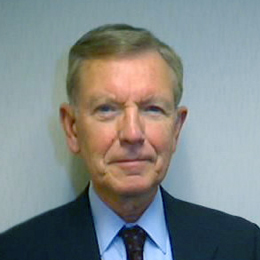Maj Gen Robert D. Eaglet, USAF (ret.)
General Robert D. Eaglet retired as deputy assistant secretary for management policy and program integration, Office of the Assistant Secretary of the Air Force for Acquisition, Washington, D.C.
General Eaglet entered the Air Force from Cleveland, where he graduated from East High School. He received a bachelor of science degree in electrical engineering from the University of Arizona in 1962 and a doctorate in electrical engineering from the University of Southern California in 1970, both through the Air Force Institute of Technology program.
The general was selected for the aviation cadet program and received his wings and commission in March 1956 as a distinguished graduate. He then attended advanced all-weather interceptor pilot training at Perrin Air Force Base, Texas, where he remained for four years as a T-33 and F-86 instructor pilot with the Air Training Command.
After graduating from the University of Arizona in 1962, General Eaglet received his first Air Force Systems Command assignment to Space Systems Division in Los Angeles. There he managed guidance and control technology programs, and conducted planning activities for future space systems.
From August 1965 to January 1966 the general was assigned to the 21st Tactical Air Support Squadron, Republic of Vietnam, where he served as a forward air controller in support of the Vietnamese army. He then served as an air liaison officer and forward air controller for the U.S. Army’s 1st Cavalry Division, operating out of An Khe, Republic of Vietnam. The general flew more than 500 combat missions, mostly in 0-1 Bird Dogs.
In August 1966 he returned to Space Systems Division, where he managed space electronics technology programs for a year. He then was placed in charge of developing the payload vehicle for an operational space system for an additional year. General Eaglet next spent two years at the University of Southern California.
After receiving his doctorate in 1970, the general was assigned to Headquarters U.S. Air Force, Washington, D.C., in the Directorate of Operational Requirements and Development Plans, where he was a program element manager and division chief for strategic defense programs. In July 1974 he became military assistant to the principal deputy director for defense research and engineering in the Office of the Secretary of Defense.
In July 1975 General Eaglet was named deputy program manager of the North Atlantic Treaty Organization Airborne Early Warning Program Office in Brussels, Belgium. After the NATO defense ministers’ decision to procure a force of E-3s, the general was appointed deputy general manager of the NATO Airborne Early Warning Program Management Agency. He transferred to Air Force Systems Command headquarters in July 1979 as assistant deputy chief of staff for plans and programs, and was named deputy chief of staff for plans and programs in February 1983. In July 1984 he became deputy commander for research, development and acquisition, Armament Division, Air Force Systems Command, Eglin Air Force Base, Fla.
General Eaglet assumed duties as program director for the F-16 multinational fighter program at Air Force Systems Command’s Aeronautical Systems Division, Wright-Patterson Air Force Base, Ohio, in July 1986. He supervised the introduction of the Block 30 series of F-16s, with alternate fighter engines and advanced medium range air-to-air missile capability, and the Block 40 series, with night and under-weather attack capabilities, as well as F-16 deliveries on behalf of 10 allied nations. He became assistant deputy, Office of the Assistant Secretary of the Air Force for Acquisition in July 1989. He assumed his present position in June 1990.
The general is a command pilot with more than 5,000 flying hours, including 1,000 combat hours. His military awards and decorations include the Distinguished Service Medal, Silver Star, Defense Superior Service Medal, Legion of Merit with oak leaf cluster, Distinguished Flying Cross with oak leaf cluster, Bronze Star Medal with “V” device, Purple Heart, Meritorious Service Medal, Air Medal with 25 oak leaf clusters, and several unit and foreign citations. The University of Southern California School of Engineering designated him as Outstanding Alumnus for 1984.
He was promoted to major general Nov. 21, 1985, with date of rank Dec. 1, 1982.
